Related Research Articles
Byzacena was a Late Roman province in the central part of Roman North Africa, which is now roughly Tunisia, split off from Africa Proconsularis.

El Djem or El Jem is a town in Mahdia Governorate, Tunisia. Its population was 21,576 during the 2014 census. It is home to some of the most impressive Roman remains in Africa, particularly the world-famous "Amphitheater of El Jem".

The name Early African Church is given to the Christian communities inhabiting the region known politically as Roman Africa, and comprised geographically somewhat around the area of the Roman Diocese of Africa, namely: the Mediterranean littoral between Cyrenaica on the east and the river Ampsaga on the west; that part of it that faces the Atlantic Ocean being called Mauretania, in addition to Byzacena. Thus corresponding somewhat to contemporary Morocco, Algeria, Tunisia and Libya. The evangelization of Africa followed much the same lines as those traced by Roman civilization.

Enfidha is a town in north-eastern Tunisia with a population of approximately 10,000. It is visited by tourists on their way to Takrouna. Enfidha is located at around 36°8′7″N10°22′51″E. It lies on the railway between Tunis and Sousse, approximately 45 km northeast of Sousse and a few kilometres inland from the Gulf of Hammamet. The nearby Enfidha – Hammamet International Airport opened in 2009, serving charter flights from several European countries.

Maktar or Makthar, also known by other names during antiquity, is a town and archaeological site in Siliana Governorate, Tunisia.
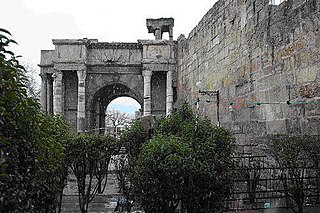
Tébessa or Tebessa, the classical Theveste, is the capital city of Tébessa Province region of northeastern Algeria. It hosts several historical landmarks, the most important one being the wall that surrounds the city and its gates. The city is also known for its traditional Algerian carpets. Tébessa was home to over 190,000 people in 2007.

Uppenna or Upenna is a Tunisian archaeological site located on the site of the present locality of Henchir Chigarnia. The site has delivered a basilica and the remains of a fortress.
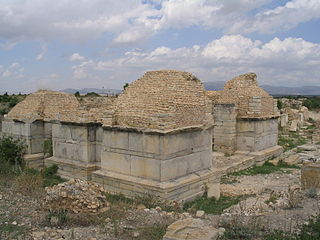
Segermes is an ancient town in Tunisia. Under the Roman Empire, the city belonged to the province of Byzacena. The town is identified with ruins at Henchir Harat, Zaghouan( 36° 20′ 43″ N, 10° 18′ 03″ E).
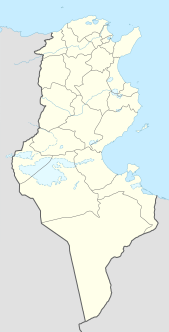
Thyna, formerly Henchir-Tina, is a town and commune in the Sfax Governorate, Tunisia. As of 2004 it had a population of 26,635. It is located on the coast about 12 km (7 mi) south of Sfax.
Henchir-Tebel is a town and archaeological site in Al Qayrawān, Tunisia located at latitude 35.3442N, longitude 10.0514E, near Kairouan
Rougga is a town in southern Tunisia located in Sfax Governorate, on the Oued er Rougga wadi. Rougga is the Berber name of the town, which is known as Raqqa in Arabic. The town is located on the site of Ancient Roman African city and former bishopric Bararus, which remains a Latin Catholic titular see.
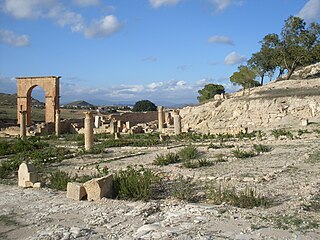
Pheradi Majius is a locality and archaeological site in Tunisia located at 36.250003°N 10.397047°E near the modern town of Sidi Khalifa in Sousse Governorate, Tunisia that is located at 36° 14′ 58″ N, 10° 23′ 57″E.

Henchir Bez is an archaeological site in Tunisia, located at 36° 00′ 23″ N, 9° 32 in the hills overlooking the Oued Miliane river, west of Tunis. Identified by a recently discovered inscription, it is the ruins of the Roman civitas of Vazi Sarra, which include a Christian Basilica and a Byzantine/Roman fort.
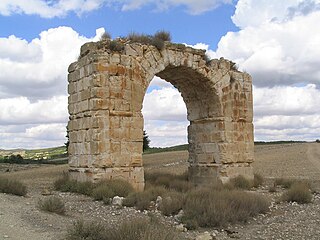
Oum El Abouab also known as Seressi is a town in Zaghouan Governorate, Tunisia that is located at 36° 10′ 00″ N, 9° 46′ 20″E. It is at an altitude of 2000m.
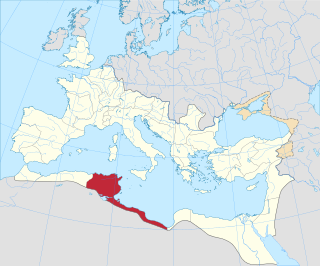
Henchir-Madjouba is a locality and archaeological site, near the headwaters of the Medjerda River in Tunisia, North Africa. It is located at 8.50238n, 35.80905e. The site is tentatively identified with the ruins of the Roman era town of Tituli. which was a civitas of the Roman Province of Roman North Africa.

Henchir-Aïn-Dourat, also known as Ad-Duwayrat or Henchir Durat, is a former Roman–Berber civitas and archaeological site in Tunisia. It is located at 36.767496n, 9.524142e, in the hills just north of Toukabeur and 15.3 km from Majāz al Bāb. It was an ancient Catholic diocese.
Henchir-El-Meden is a locality and archaeological site in Tunisia.

Gunela was an ancient Roman-Berber town and archaeological site in Bizerte Governorate, Tunisia. It was located at 37.165524n, 9.765536e, within the suburbs of Tinja, Tunisia.

Henchir-Sidi-Salah is a rural locality and archaeological site in the hinterland behind Sfax, Tunisia.

Tabalta was an ancient Roman-Berber city in the province of Africa Proconsularis and of Byzacena during the late antiquity. It was a Catholic diocese led by Juan Bustos.
References
- ↑ http://imperium.ahlfeldt.se/places/22079.html
- ↑ Anna Leone, Changing Townscapes in North Africa from Late Antiquity to the Arab Conquest (Edipuglia srl, 2007) p271.
- ↑ Susan T. Stevens, Of martyrs and mosaics: two Early Christian churches at Sidi Jdidi (Aradi) and Henchir Chigarnia (Uppenna) Journal of Roman Archaeology Volume 20.
- ↑ Amphitheatre, Henchir Chigarnia.
| This Tunisia-related article is a stub. You can help Wikipedia by expanding it. |